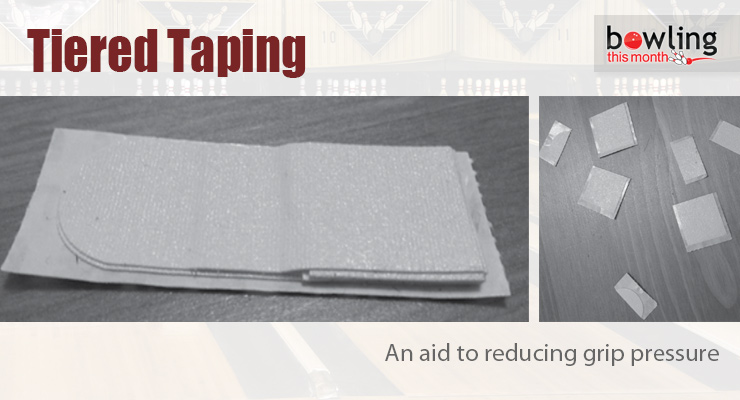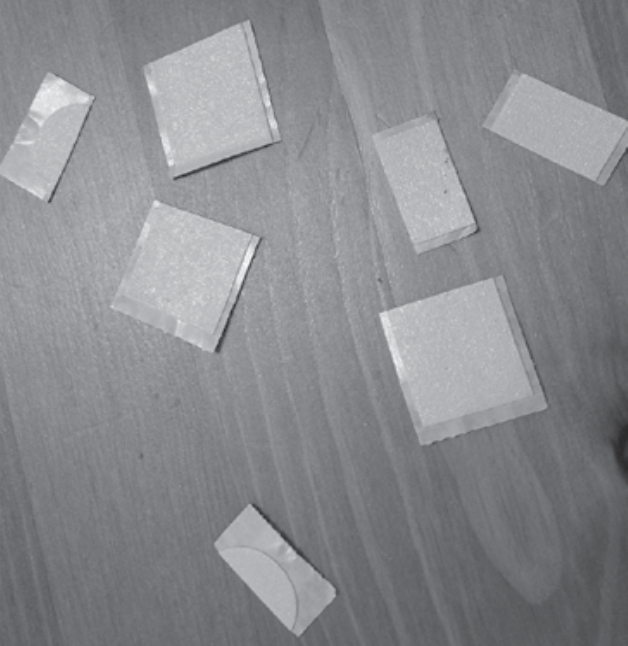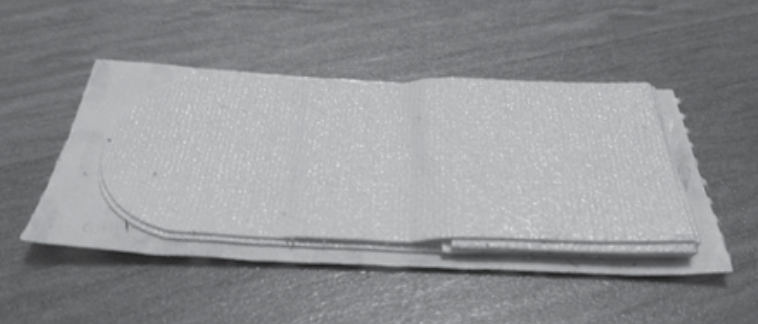Historically, the anatomical nature of the human thumb has presented an enigma for pro shop operators, coaches, and players. With orthodox drilling methods, it is difficult to obtain a fit which prevents the bending of the thumb at the bottom of the hole while fitting the hole well at the top.
The thumbhole will fit at the top or fit at the bottom but not both. A thumbhole which fits the base of the thumb can’t fit well on the tip because the shape of the thumb will leave extra space on the bottom of the hole. Thus, bowlers must bend the thumb at the knuckle to grip and swing the ball as it enters into the swing, throughout the swing, and into the release.
This will delay the exit of the thumb. On the other hand, taping a hole with full pieces of tape, which creates a good fit at the tip of the thumb, would create a hole which is too tight at the top, also delaying the release since the tape acts like a braking mechanism.
This month I’ll discuss a taping procedure which can help you improve your swing and release. The tiered taping procedure will eliminate the bending of the thumb and reduce thumb bending grip tension.
What it is
Tiered taping is the strategic layering of tape with three thicknesses: full length, half, and quarter length pieces. The major objective of tiered taping is to eliminate the bending of the thumb since this knuckling creates excessive grip pressure and delays the thumb exit. This taping procedure is based on the premise that the tip and middle section of the thumb would both require more tape thickness as compared with the base of the thumb (near the palm).
Tiered taping will be defined by tape thickness values at three zones: the tip, middle, and base of the thumb. To illustrate, a 5-3-2 tiered taping would include 5 pieces at the tip, 3 pieces in the middle, and 2 pieces at the base.
The tiered taping process requires several efforts to customize for each individual’s thumb shape. I recommend you experiment until you discover what works best for you.
Release and swing problems
Many release, swing, and timing problems can be traced to excessive grip pressure facilitated by thumb bending induced tension. Specifically, the anatomical nature of the thumb leads to a problem to grasp and swing the bowling ball without bending the thumb. In fact, this is so common, you will see bowlers with burn marks at the tip of their thumb. Here are some common problems associated with excessive grip tension.
Problem area #1: swing start movement and timing
With the hole too large on the bottom, the first problem area will be the swing start fluidity and overall movement. Since the thumb is bent, increasing grip pressure, the player will squeeze more firmly as the ball moves downward and encounters gravitational forces.
Instantly, this leads to a braking effect as the ball transitions from a supported position downward to a position with no support. This will cause slower feet, reduced forward spine tilt, late timing, and swing movement shapes that reduce energy transfer from bowler to bowling ball.
Problem area #2: release
With excessive thumb tension, the thumb will be delayed in exiting the ball reducing the separation between the thumb and fingers. Moreover, the thumb will remain in the ball longer, reducing the rev rate since the arc line length the fingers can travel will be shortened. This reduces the overall potential ball motion. Often, this will also lead to the player rotating over the top of the ball.
Potential injuries
Worse than detrimental physical game effects of excessive grip pressure are repetitive stress injuries associated with excessive tension in the grasp. Over time, this unnecessary pressure creates strain on the wrist and elbow. With repetitive stress, the added tension of the thumb can lead to injuries of the wrist or elbow. Some common potential injuries associated with excessive thumb pressure include:
- DeQuervain’s tendinitis: Two of three major thumb tendons run through a channel on the thumb side of the wrist. When tendons on the side of the thumb become inflamed, the lining of the tendons can become swollen causing the tendon movement to be inhibited. This can cause pain on the thumb side of the wrist as well as potential wrist weakness. Using an anti-inflammatory medication and a support splint or brace is recommended when experiencing discomfort. Please consult a physician before beginning any exercise program or medication.
- Golfer’s elbow (medial epicondylitis): Flexors of the fingers insert at the medial epicondyle at the inside of the elbow. So, with repetitive motion that includes excessive grasping and gripping, the tendon can become inflamed. It is also aggravated by the resistant forces of wrist flexion (cupping). Squeezing a tennis ball, wrist curls, and reverse wrist curls are recommended to help with this injury.
- Tennis elbow (lateral epicondylitis): A similar overuse injury to medial epicondylitis is tennis elbow. Tennis elbow is the inflammation of the area on the opposite side of golfer’s elbow, the outside. Symptoms include pain on the outside of the elbow and a weak grip.
- Carpal tunnel syndrome: The median nerve provides feeling for the thumb, index, ring, and middle finger. When this nerve becomes compressed due to repetitive grasping and flexing of the wrist, the carpal tunnel space shrinks due to inflammation of the nerve. When swelling increases, it is possible that numbness or pain can move from the center of the ring finger all the way to the thumb. In addition to pain, this can also weaken one’s grip.
Taping procedure
To improve the grip, I strongly recommend testing the tiered taping process. Here are the step-by-step directions on how to construct a tiered taping. Read the instructions as well as review the photos for each step.
Step 1: Estimate the thickness of each level of the thumb
Turn your thumb to the side and look at it. Study the thickness difference between the base, middle, and tip of the thumb. How much variation do you notice? Are there three layers? Two layers? Estimate how much difference you will have at each level. Ideally, there should be one full tape at the top. Changing the top tape every three games is recommended to minimize unnecessary grip pressure resulting from oil and residue.
Step 2: Calculate needed tape
Calculate how many half and quarter pieces you will need. Remember that the goal is one full base piece and one full piece which would be put on top. For example, a 6-3-2 will require 4 half pieces and 1 quarter piece. The half pieces would go on the bottom of the tape and the quarter pieces will go just above the half pieces.
Step 3: Preparing the tape
Cut the rounded top off a full piece of tape. Prepare the half pieces by cutting the full piece of tape into two equal pieces. To make a quarter piece, cut the half piece in half. With each of these, you can use 2 half pieces, 1 half and 2 quarter or 4 quarter pieces.
Step 4: Putting it all together
With your calculation and initial experimentation, construct a tiered tape with the half and quarter pieces. Begin with a full length normal 3/4” white tape. Attach the half pieces to the bottom of the full piece (non-rounded end). Then add the quarter pieces just above the half pieces to make the middle thickness. Ideally, place one full piece on top of this. The rounded end will be on top of the top, nearest to the palm.
Step 5: Place the tape
The finished tiered tape should be placed at approximately 1 o’clock for a righthander and 11 o’clock for a lefthander (where the top of the hole, closest to the grip center, is 12 o’clock). To test the exact location of where your tape should go, place your fingers in the hole and then put the thumb in and note the opposite side intersection. This should be 90 degrees relative to your oval angle cut.
Conclusion
A product called Thumb Straight was sold in the past and is still available. I believe the thickness of the long portion of the device and the overall bulkiness make it difficult to use as compared with the tiered taping method. It also does not allow the customization of the tiered taping method.
Tiered taping presents a relatively easy method to improve the grip and reduce unnecessary thumb tension. With a reduction of a bent thumb knuckle, a player will instantly realize improvements in the swing start, swing, and release. Tiered taping will take a few efforts to customize perfectly for you and your unique thumb shape. But, the experimentation will lead to a significantly more enjoyable experience on the lanes.
I have created a Change Your Damn Tape Facebook group. I encourage you to join and post your tiered tape construction and successes utilizing this tension reduction method. Members of the group have been experiment – ing with tiered taping and developed unique solutions for themselves, which they share. We have seen many successes with this process with members stating their accuracy is improved and their swing/release is effortless. You, too, could enjoy these benefits by trying tiered taping.
Image Credits: Bowling center background image is licensed for use by BTM and is the copyrighted property of its original creator (©iStock.com/CathyDonohoue). Unauthorized reproduction and/or reuse is prohibited.


